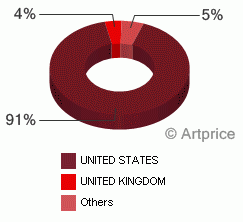Robert Rauschenberg (1925)
[2003年05月15日]
After a decade of stagnation the prices of the first American artist to win the Venice Biennale are finally rising again
Rauschenberg was born in Texas in 1925 and only started his artistic career after the war, training at the Art Institute of Kansas City and then the Académie Julian (Paris) in 1947-48. It was there he began a series of black and white monochrome works and also befriended John Cage and choreographer Merce Cunningham before his work launched into a critical rereading of abstract expressionism. The Combine Paintings of the fifties were collages of found objects developing the concept of the ready-made. In 1953 he set up studio next door to Jasper Johns. From 1958 on, he was exhibiting his assemblages at the Leo Castelli gallery and continued to work in the same vein until 1962, when he embarked on canvas silk-screens themed around the mass media, dear to all Pop Artists. The Jewish Museum of New York held his first retrospective the following year and he won the Venice Biennale in 1964. In 1966 Rauschenberg and electronics engineer Billy Klüver set up the research unit Experiments in Art and Technology. In 1998, a major itinerant retrospective testified to 40 years of fecund creative work that covered painting, sculpture, installations, photography and ceramics among other forms.
Artworks at auctions
The diversity of his work is reflected in the wide range of prices paid at auction. Of the 441 Rauschenberg pieces auctioned between 1999 and 2002, half went for less than EUR1,500 while the top price over the period was USD1.2 million, paid in 1999 for a small untitled assemblage from 1954. The wealth of cheaper pieces owes much to the profusion of prints on the market, making up 76% of his output sold at auction. That said, large format lithographs from the 1960s such as the Breakthrough I and Breakthrough II series from 1964-65 or Booster from 1967 regularly command more than USD30,000. Drawings average USD10-15,000. But the transfer drawings, made by transferring printed images from colour magazines in the late 1950s can go for a lot more. Drawing for President of the USA with Dantewas knocked down for USD425,000 at Sotheby’s on 8 May 2000. Photographs, which make up less than 2% of the market rarely fetch more than USD3,000. As for paintings, his most sought-after works are the Combine paintings of the 1950s, but they are also the hardest to find. His record price is for Rebus (1955), an assemblage more than 3 metres long that sold for USD6.6 million in 1991. This made him the third most expensive Pop Artist after Andy Warhol and Jasper Johns. Works from after the 1960s are not so popular. The most expensive, Tribal Quarterly, a very large format from 1977 only made USD180,000 in June 2000. Eighties pieces rarely go for more than USD100,000. Novel Quote, a very large format (305 x 244 cm) from the 1988 Urban Bourbon series failed to find a buyer in its estimated range of USD100,000-150,000.
The market places
The US is the hub of the Robert RAUSCHENBERG market and 91% of his work is sold at auction there. His best pieces often feature in the New York sales of May and November, such as the Contemporary Art — Evening catalogue for Sotheby’s 13 May 2003 sale. But less expensive pieces are still often found in Germany, Switzerland, Sweden, the UK and France. Nearly 40% of all lots are sold in Europe.
Buy or sell
After a decade of stagnation his prices are finally rising again. They doubled in 2002. This has much to do with a sharp contraction of supply. Collectors had nearly twice as many lots to choose from in 2000 as in 2002. In this context the good lots tend to be snapped up. And knowing this, collectors are willing to put up their historic pieces, such as Minutiae, a 1954 assemblage created for the dances of Merce Cunningham sold on 13 May 2003 at Sotheby’s. Minutiae was estimated at EUR6-8 million but found no buyer willing to go above the reserve. In contrast to the paintings and drawings, the current value of prints has failed to rise much, just 22% in five years. In the last few months it has even tended to fall. For instance, Two Reasons Birds Sing, a 1979 lithograph printed in a limited edition of 100 was selling for USD1,000-1,300 between 2000 and 2002 but failed to find a buyer at USD850 at Christie’s in February 2003.
Robert Rauschenberg Artprice Indexall media categories, base January 1997 = 100, currency: EUR  Robert Rauschenberg Lots sold at auctions
Robert Rauschenberg Lots sold at auctions  Robert Rauschenberg Auction sales turnover 1999-2002 / weight by country
Robert Rauschenberg Auction sales turnover 1999-2002 / weight by country  © Artprice
© Artprice




 0
0
